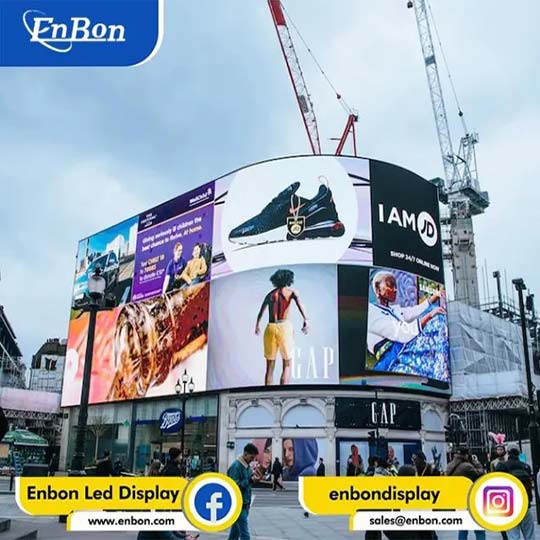
Have you ever wondered, "How do outdoor LED displays work?" They're everywhere we look — advertising products, displaying public messages, or even showcasing stunning visuals in public places. These outdoor LED screens have become such a pivotal part of our everyday landscape, but the technology behind them remains a mystery for many. Let's illuminate the world of these bright, vibrant outdoor LED display boards, breaking down the complexities into simple explanations.
Outdoor LED displays work by utilizing light-emitting diodes (LEDs) that emit light when an electrical current is applied. They create images by organizing these LEDs into pixels, which are then controlled by a computer to display the desired content.
With that basic understanding in mind, wouldn't it be fascinating to dig deeper? Have you ever pondered over how these displays can withstand various weather conditions? Or how the images we see are so vivid, despite being viewed from different angles? Let's unravel these mysteries as we delve into the technological marvel that is the outdoor LED display.

The LED: The Heart of the Display
An LED, short for light-emitting diode, is at the core of any outdoor LED display. This tiny semiconductor emits light when an electrical current passes through it. An outdoor LED screen, whether it's used for advertising or any other purpose, comprises thousands of these LEDs.
Each LED functions as a single pixel, the smallest controllable element of a picture on display. The light emitted by each LED combines to form the image we perceive. However, what makes an LED suitable for outdoor display? Let's explore this in detail.
Advantages of LEDs in Outdoor Displays
LEDs are popular choices for outdoor displays due to their versatility, durability, and energy efficiency. They can operate effectively in a range of temperatures, making them ideal for various climates. Plus, they are highly energy efficient, consuming less power compared to traditional lighting methods. This feature makes them particularly advantageous for large-scale, outdoor LED display boards where energy usage can be significant.
LEDs also offer high brightness and contrast ratios, essential for visibility in outdoor settings. With superior brightness levels, LED displays remain clear and vibrant, even in direct sunlight.
These qualities make LEDs the preferred choice for outdoor displays, setting the standard in the industry. LED Pixels and Their Importance
Each LED pixel plays a crucial role in an LED display screen for advertising outdoor or indoor usage. A pixel usually consists of three red, green, and blue LEDs. By manipulating the intensity of these three colors, any color within the visible spectrum can be created. The combination of these colored LEDs determines the overall color and brightness of the pixel.
The resolution of an LED display, which contributes to the clarity of the image, is determined by the number of pixels it contains. A higher pixel count generally means a sharper image. Therefore, LED displays for up-close viewing often have a higher pixel density to ensure a crisp, clear image.
Outdoor LED Displays: Weathering the Storm
One of the challenges of an outdoor LED display is its ability to withstand harsh weather conditions. Whether it's a scorching summer day or a frosty winter evening, outdoor displays must perform consistently. They are also expected to resist rainfall, dust, and other environmental factors. How does this technology manage to endure such conditions?
Materials and construction play a significant role here. Outdoor LED screens are typically encased in durable, waterproof materials to protect the internal components from moisture and other damaging elements. Additionally, they incorporate advanced heat dissipation mechanisms to ensure they remain operational even under high-temperature conditions.
Moreover, each outdoor LED display board is designed with a certain level of ingress protection (IP) rating. This rating indicates the screen's resilience against solid particles like dust and liquid intrusion such as rain. The higher the IP rating, the better the display can withstand the outdoor environment.
Optimizing Image Quality in Outdoor LED Displays
Quality image reproduction is vital to outdoor LED displays, especially for advertising purposes. A display that provides high-definition, vibrant, and clear images can engage more viewers and leave a lasting impression. Thus, companies like Enbon invest heavily in optimizing the image quality of their outdoor LED screens.
Brightness is one of the most important parameters in this regard. As outdoor screens must compete with natural daylight, they need a high level of brightness to ensure images are visible and vibrant. Another critical factor is the color reproduction capability of the screen. High-quality LED screens can reproduce a broad spectrum of colors, providing more accurate and lifelike images.
The viewing angle is another essential aspect. A good outdoor LED display should offer wide viewing angles, ensuring that the image quality remains consistent, irrespective of the viewer's position relative to the screen.
The Role of Software in Outdoor LED Displays
Behind the scenes of the vivid images displayed on outdoor LED screens is a complex system of software and hardware that work together to control the operation of each LED. This system, often referred to as the "controller," manages the color, brightness, and other attributes of each LED based on the input signal it receives.
The software allows advertisers to schedule, manage, and update the content displayed easily for an outdoor LED display screen for advertising outdoor events or products. Advanced software systems can even adapt to environmental conditions, adjusting the display's brightness based on ambient light levels for optimum visibility and energy efficiency.
Conclusion: The Future of Outdoor LED Displays
Outdoor LED displays have undoubtedly revolutionized the way we present and receive visual information in public spaces. Their durability, energy efficiency, and superior image quality make them an ideal solution for outdoor advertising and public messaging.
In the future, we can expect more innovations and advancements in this field. Emerging technologies, such as interactive touch screens and AI integration, are paving the way for even more exciting possibilities. As we continue to push the boundaries of what is possible with outdoor LED displays, one thing is certain — the future of outdoor visual communication looks bright and vivid, much like the LED displays we've grown so accustomed to seeing.


